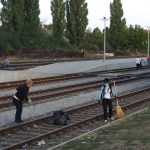Croatia. So where is it exactly anyway? And is it safe?
Located somewhere in Eastern Europe, Westerners have often had trouble with the geography of Croatia. A part of former Yugoslavia, the newest version of Croatia – the modern independent one – is less than 25 years old, and given the trauma in the region in recent decades, tourists comfortable in destinations like Spain and Greece can be excused a certain level of ignorance.
The recent terror attack in Paris, and the confirmation on November 16, 2015, that a passport alleged to belong to one of the bombers had passed through Croatia on October 8, has raised – in some quarters at least – questions about the safety of Croatia as a tourist destination, specifically in terms of emails to this portal after we published the story earlier today. Despite the tragic recent events, I will confess to a wry smile when the first email came in.
For we were going back in time…
The year is 2002. An Englishman working as an aid worker in Somalia has just returned from two holidays on his accumulated days off. The first – to Mumbai just as a major nuclear stand-off with Pakistan was escalating – was followed by seven days in Israel, the West Bank and Gaza. The Englishman, a veteran of the Rwandan genocide, had (incorrectly) the label ‘war zone junkie’ written all over him, and several of his friends expressed concern when he announced he was buying a house on an island in Croatia in 2002.
Croatia? Wasn’t that part of the Balkan quagmire and too dangerous to visit? Indeed it had been seven years hence, although the island itself suffered no direct action save a blockade and a couple of cursory bombs on the cleared strip of a UNESCO World Heritage Site which passes off as the island’s ‘airport’.
As this war zone junkie fielded email after email advising me to get psychiatic help, I responded in the only way I could – by sending pictures of the house, town and heavenly island I had discovered off the beaten track. My friends – shocked at the beauty and tranquility, having assumed I was seeking something else – begged for more information. My house was completely full in my absence that summer, and several friends are now home owners on Hvar.
I mention the story for to me it is similar to what is happening today. Croatia has been in the news more than most countries regarding the migrant crisis in recent weeks, not so much because it is a dangerous and violent place, more because it is a country which has shown its humanity – partly the result of its own painful recent past, perhaps – where neighbouring countries have shut their doors. It would have been easy for Croatia to follow the example of Hungary, erect a fence, and ignore the migrant misery on its borders.
Croatia chose not to, and while I have issues with the current government, their handling of the crisis has been humane and exemplary, and it has done much to enhance Croatia’s reputation internationally. As long as Germany has kept its open door policy, Croatia has argued that it is merely a transit route to the final destination. And what are the statistics?
Almost 400,000 migrants and refugees have now passed through Croatia in recent weeks. Just 10 (including two Cubans and a Russian) have applied for asylum, meaning 399,990 or so have – or are in the process of – passing through. There have been two refugee births and one death from natural causes, and no major incidents of crime or violence. Migrants and refugees enter the country from Serbia, pass by a transit camp, and they are then escorted to the Slovenian border and onwards. What tensions occur tend to happen at border crossings, far away from the beaches of Dalmatia.
What does this have to do with Croatian tourism? Absolutely nothing, apart from one thing – if, like me, you have been impressed by Croatia’s humane handling of the crisis, you might consider vacationing here to find out more about the country’s exceptional hospitality.
For such a huge amount of temporary visitors, the effect on everyday life has been minimal, especially in the tourist areas, for two reasons. Firstly, it is winter, and as 99% of Croatian tourism is based on the summer and shoulder seasons, the crisis has not really impacted the tourist season in terms of timing. The migrant crisis is an EU crisis, and one would hope that a solution to the current status quo must be found in the coming weeks. And secondly, the bulk of Croatian tourism takes place on the Adriatic coast and islands, a different world from the migrant route, and akin to being in St Tropez and hearing about the horrors of events in Paris.
Croatia is safe. Croatia is stunningly beautiful. Croatia is humane. And looking forward to your visit.









